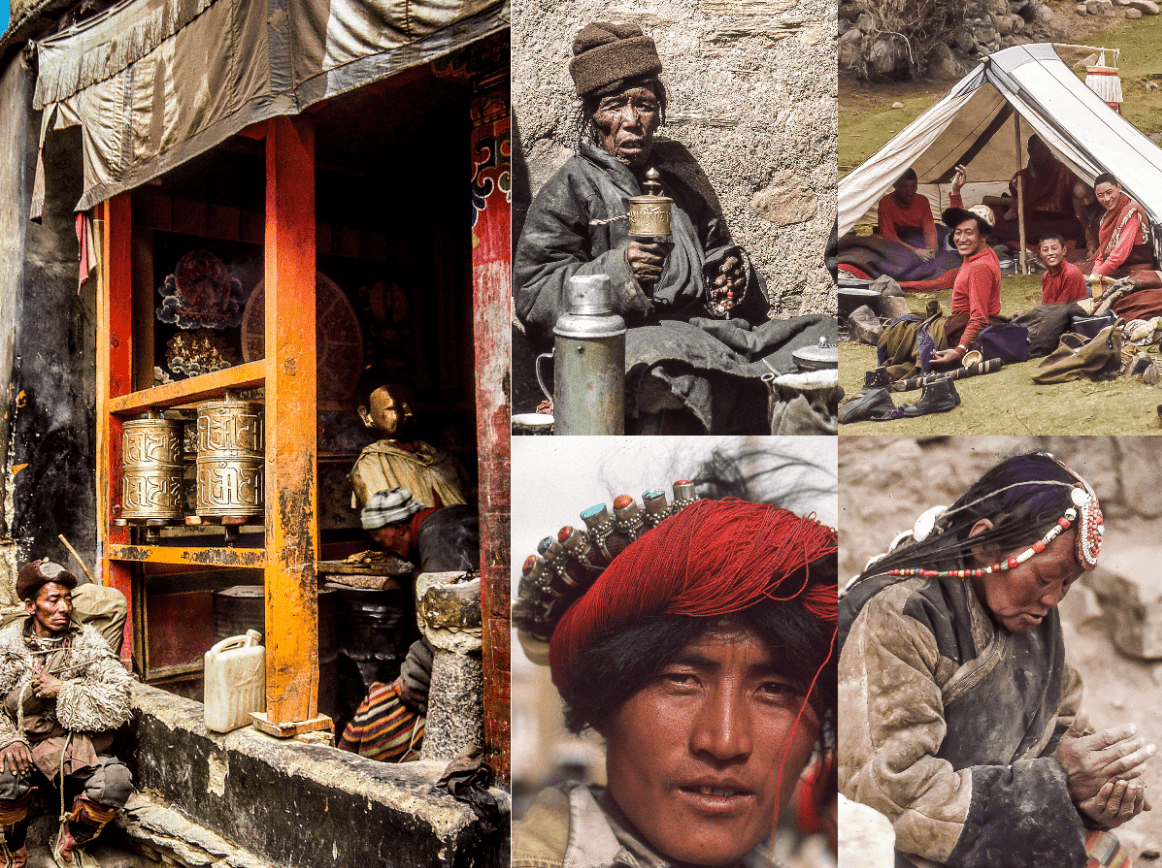
I will never forget the moment I took this photograph. It was late afternoon, some fifty kilometers north of the Nepal-Tibet border crossing at Zhangmu. Atop the barren Tibetan plateau some 4,500 meters above sea level, it got cold and a fierce wind was blowing. The setting sun was magical, alas, blinding at this altitude. Yet, a village woman cast her defiant look straight in its direction, as if to quell its piercing rays. The look in her eyes, the harsh, wrinkled face chiseled by icy winds that whip the prayer flags to frenzy atop the highest region on Earth. Stretching to the south, the snow-covered peaks of the High Himalaya — Gaurishankar, Cho Oyu, Mt. Everest massif, areas where I trekked last only a year earlier — loomed steadfast under the azure sky. The Nepal midlands and the Indian subcontinent extending far beyond to the south, now only an image etched on my mind, invisible.
After my treks through the Nepal Himalaya in the 1970s, I was eager to visit Tibet. Unfortunately, Tibet was still off limits to visitors for much of the decade. But in the late 1970s, at last, as the dust settled on China’s tumultuous Cultural Revolution, the newly opened Kodari Bridge became a threshold to a world awakening from a long slumber. Mere 2,300 m (7,500 ft) above sea level, in the rain shadow of the High Himalaya, spanning the Bhote Koshi River, the Kodari Bridge in the early 1980s turned into a gateway to Tibet, with Kathmandu as the staging point for the arduous journey to Lhasa and the “Roof of the World”.
The Cultural Revolution, a decade of political and social upheaval, had cast a long shadow over China. Tibet, a land steeped in ancient traditions, felt the brunt of this ideological purge. Ransacked and destroyed, some 6,000 Buddhist monasteries stood in ruin across the desolate high altitude landscape. Religious practices outlawed, tens of thousands of monks and nuns dead or in reeducation camps, fifteen hundred years of unique Tibetan cultural identity became threatened.
I was fortunate to be among the first handful of intrepid travelers that stood at the precipice of history, ready to cross the Kodari Bridge and ascend into the icy winds atop the plateau. I recall my anticipation as I walked alone across the bridge to the Chinese side of the border. The morning I did, I was the only Western traveler making my way across and then steeply up into the thin air of 4,000 to 5,000 meters (13,000 to 15,000 feet) in altitude. Nepal, a vibrant tapestry of cultures, would give way to the stark beauty of the Tibetan plateau. Villages nestled amongst soaring peaks, prayer wheels turning in the wind — these would be the first sights to greet me. But the real intrigue lay beneath the surface as I uncovered it in the days ahead.
The Tibet I encountered would be a land in transition, during a time of immense change, a chance to witness a culture rise from the ashes, stronger and more vibrant than ever before. Monasteries, once silent testaments to a vibrant faith, would slowly stir back to life. Monks, hesitant at first, would emerge from the shadows. Some only recently returned from prisons, their maroon robes a stark contrast to the desolate landscape. The air would be thick with a blend of hope and uncertainty.
The journey between the Nepal border and Lhasa I experienced was unlike anything I could have imagined, and would be impossible to repeat in the years to come. This was the time to roam freely across the vast, frozen plateau and the craggy remote mountains. Scaling steep slopes dotted with isolated monasteries, I witnessed them coming alive, often with only one or two monks rebuilding their isolated outposts of faith. The views and panoramas of and from these isolated locations and frontiers of once thriving monastic settlements were breathtaking. The monks and villagers that came to help them rebuild were so hardened by life, and stoic, yet friendly, all the while they focused on their quest where time did not matter.
My treks into remote pockets of Tibet along the skeleton of a new road connecting remote villages between the Kodari Bridge and the reawakening towns of Shigatse and Gyantse en route to Lhasa were absolutely spontaneous, unhindered by checks and permits. But that changed once in Tibet’s capital in a brief span of 2 to 3 years. The more travellers arrived in Tibet, by then also by air, the more they faced strict rules and regulations curtailing free movement without permits and needing to be accompanied by guides. Culminating with March 8, 1989, when Chinese authorities imposed martial law on Lhasa, the decade at the beginning of which I experienced Tibet’s unique slice of history was over.
Indeed, I was most fortunate to discover the many amazing places between the Nepal border and Central Tibet. Mesmerized by my experience, from Lhasa I continued across Tibet north to Qinghai and on to Xinjiang, the Chinese Turkestan, at the time also still undiscovered by tourism. Crossing Xinjiang, eventually I traversed the Khunjerab Pass into Hunza in Pakistan. Trekking in the Karakoram, roaming about Hindukush, yet another frontier virtually unknown to outside visitors, still years before the real onset of mass travel. And little did I know then where everywhere else would my travels take me thereafter.
